Admins need to be able to handle and track IP addresses across their network. As I’ll explain below, this task is best handled by an automated tool, because keeping tabs on IP addresses can be time-consuming and confusing. If you’re looking for an enterprise-level tool for tracking IP addresses, I suggest starting with SolarWinds® IP Address Manager.
What Are IP Addresses?
Why Are IP Addresses Necessary?
Allocating and Managing IP Addresses
What Are IP Trackers?
What Are the Types of IP Address Trackers?
What Are IP Grabbers?
Why Is IP Tracking Useful?
7 Best IP Address Trackers:
- Solarwinds IP Address Manager
- Advanced IP Scanner
- Angry IP Scanner
- SoftPerfect Network Scanner
- LizardSystems Network Scanner
- B-Labs Bopup Scanner
- MyLanViewer Network/IP Scanner
Which IP Address Tracking Tool Should I Choose?
Why is tracking IP addresses a challenge? Imagine a network environment is like a neighborhood. The houses, apartments, and businesses are akin to nodes, and the roads and sidewalks are the routes people—or data, in this analogy—use to move from place to place. Just how every building and property has a unique address to locate, reach, or contact it, every device connected to a network has a unique identifier for similar purposes. With a large number of devices on a dynamic network, tracking these many addresses accurately can be a struggle.
What Are IP Addresses?
The vast majority of networks today use transmission control protocol/internet protocol (TCP/IP) to manage how computers connect to and communicate over networks. Within this system, the unique identifier assigned to each given computer is known as its IP address.
There are two different kinds of IP address: IPv4 and IPv6. All networked machines have an IPv4 address, and many are now using the updated IPv6, as well. The difference between the two is IPv4 uses 32 binary bits to distinguish each unique address—resulting in a base-10 address expressed as four numbers separated by periods, such as 111.22.33.444. Meanwhile, IPv6 uses 128 binary bits to create eight base-16 numbers separated by colons, such as 1111:2222:3333:4444:5555:6666:7777:8888.
Why Are IP Addresses Necessary?
The history here is when IPv4 protocol was first implemented, the internet—and our everyday reliance upon it—was far, far smaller than it is today. The vast majority of networks were private and separate, meaning different devices on different networks could have the same IP address without causing any issues.
As the internet became increasingly popular and more connected, it made sense to have a universal standard for networked communications. However, considering IPv4’s 32-bit structure allows 232 possible combinations—or about 4.3 billion unique addresses—many were concerned by the possibility of running out of usable IP addresses. IPv6 raises the ceiling from 232 combinations to 2128, essentially removing this concern. These days, IP addresses are an integral part of every device’s configuration and design.
While each device’s unique IP address allows it to be distinguished from every other device on a network, there can be hundreds—if not thousands—of devices connected to a given network, making it difficult to manually organize and sort through all the IP addresses. That’s where IP allocation and management come into the picture, which can be overseen by IP tracker software.
Allocating and Managing IP Addresses
Networks require planning before they can be built and put into active use. One of the first steps of network planning is to prepare an IP address plan, which defines how IP addresses will be assigned. On a typical network, for example, a range of IP addresses should be reserved for servers, while others should be allocated for workstations and other network-connected devices, such as printers. This portion of network planning is fairly simple and can often be done with a spreadsheet. The next step is to assign IP addresses to devices, which can be done one of two ways:
- Static IP Addressing – manually setting IP addresses and IP networking parameters for each device is called static IP addressing. The process is often time-consuming and prone to errors but is commonly used for smaller segments of IP addresses or a limited number of devices. Other situations where static IP addressing might be the better choice are contexts where total control over IP addressing is essential, as for servers. While effective, static IP addressing is extremely labor intensive.
- Dynamic IP Addressing – the Dynamic Host Configuration Protocol, or DHCP, automatically takes care of assigning IP addresses and configuring the network parameters, by having each connected device request an IP address from a DHCP server. The IP address is leased to the device for a set period of time, after which the IP address returns to the pool of available addresses unless the device renews the lease. While largely automated, dynamic addressing still requires oversight from network admins to ensure the IP addresses are properly managed and the DHCP server is correctly configured.
What Are IP Trackers?
IP trackers are tools allowing you to detect all the devices with configured IP addresses across your network. One extremely vital function these tools provide is they’re able to reconcile the configured devices configured with what your network has documented. The reason this is so vital is because IP address management systems without accurate documentation and records are massively less effective.
There are two approaches to reconciliation among IP tracker software solutions: those matching actual configurations with database information and list the discrepancies, and those matching and attempting to fix the errors detected within the IP management system. Many IP address tracking tools are configurable, allowing them to automatically run periodically. This ensures you’re kept up to date regarding unauthorized changes and your management system’s records are accurate.
What Are the Types of IP Address Trackers?
There are several types of IP trackers to assist with the various tasks involved in IP allocation and management.
- IP Address Managers – a fairly broad category including several IP tracking tools to help streamline the process of managing IP addresses. This form of IP tracker software can run the gamut from an elaborate, function-filled toolset with DNS lookup capabilities to a barebone application designed to essentially work as a database for static IP address management.
- IP Address Trackers – applications used to help determine which IP addresses are configured on your networked devices (versus the ones your IP management system says are configured).
- IP Address Scanners – this form of IP tracker software allows you to scan a range of IP addresses. The range is customizable and can be set according to starting and ending IP addresses, or by complete subnets. IP address scanners will ping each IP address within the range and report back the ones responding. The majority of IP address scanners will automatically run a reverse DNS resolution, which brings back the hostname of each device in addition to its IP address.
What Are IP Grabbers?
It’s worth explaining in my article what an IP grabbing tool is and how it works. An IP grabber is a different kind of tool mostly used for grabbing IP addresses and collecting statistics. Put simply, an IP grabber is a third-party tool that can extract an IP address whenever someone clicks on a specific link. IP grabbing solutions can create a specific, shortened link. Whenever someone clicks on the URL, their real-time IP address is collected. Other information, such as their country, username, internet services provider, browser, operating system, host name, and more can be collected.
Many people use IP grabbing and related statistical data and metadata to gain a better understanding of the traffic flow to their websites, blogs, or forums. They can tell how many people clicked on their link and view advanced analytics for web traffic coming through the link.
However, sometimes bad actors can use an IP grabber to attain an IP address and target the network with for example a distributed denial-of-service (DDoS) attack. These malicious attacks can disrupt a network’s normal traffic flow, pushing sites and resources offline.
Why Is IP Tracking Useful?
Tracking IP addresses across networks and subnets offers several benefits:
- IP trackers allow admins to find all the IP addresses available in their networked environment and to determine the configuration status of each device,
- help to prevent addressing issues—like multiple devices attempting to use the same IP address—while also allowing admins to detect the presence of unauthorized devices,
- IP tracking management software often includes dashboards with graphic interfaces allowing for visual overviews of the entire network structure.
There are many moving parts involved in designing and maintaining the function of networks and subnets and using an incredibly useful tool like IP address tracking software will optimize the efficiency of network management tasks. The differences between IP address trackers, IP address scanners, and IP address managers are largely nominal, as many IP address tracker solutions will combine the functionality of each into a single application to give admins and support staff broad visibility into all the devices connected to the network.
Here are a few of my favorite IP tracker software options.
Best IP Address Trackers
1. SolarWinds IP Address Manager (Free Trial)
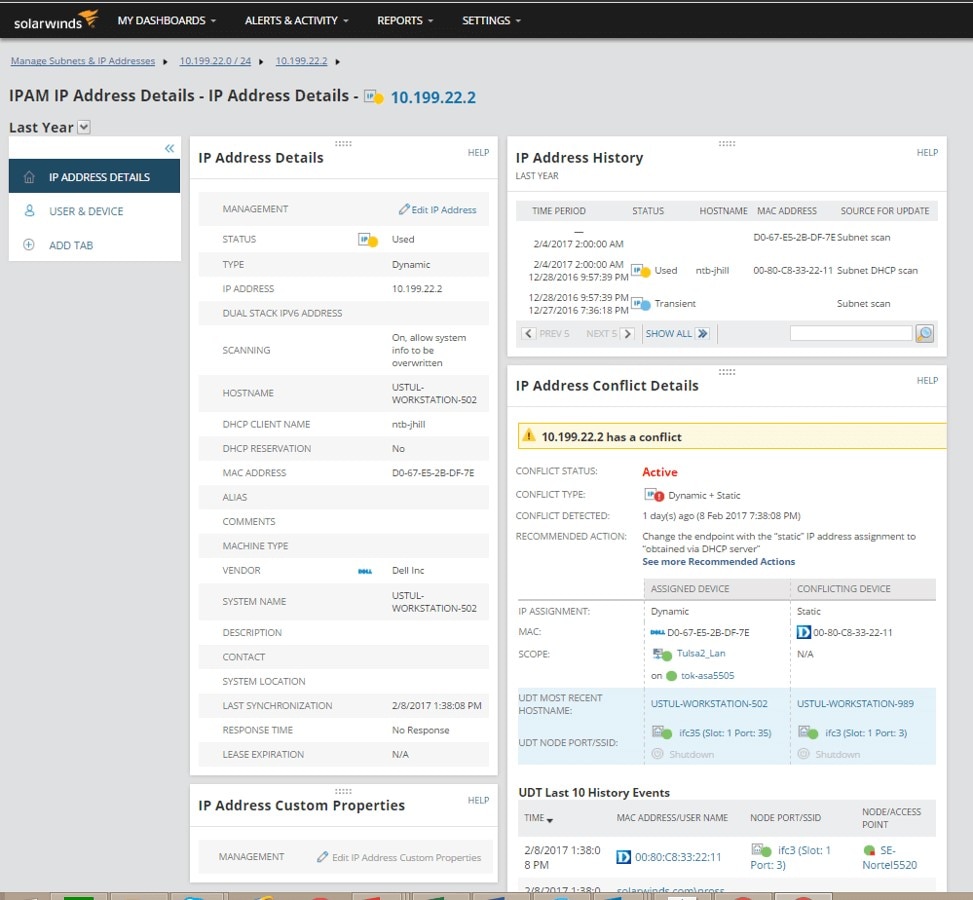
SolarWinds IP Address Manager is an excellent option for enterprises and other large organizations and can even manage up to 2 million IP addresses—which is more than enough for even the biggest networks.
IP Address Manager interacts with existing DNS and DHCP servers, which makes it a full DDI tool. IP Address Manager is compatible with Cisco, ISC, and Microsoft DHCP servers and BIND and Microsoft DNS servers. The application includes several automated and automatic features, such as IP tracking tool, IP address conflicts, mismatched DNS records, and depleted scopes. SolarWinds offers a free 30-day trial, so you can test drive the program’s full functionality before you commit to buying.
2. Advanced IP Scanner
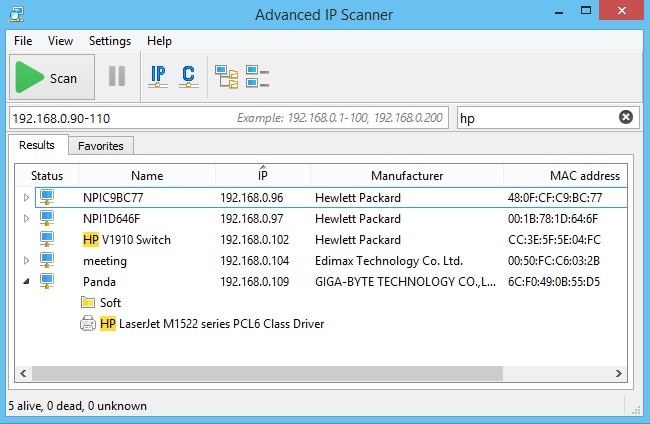
This free IP address tracker runs on and is designed for Windows operating systems. It’s simple to use—you input a range of IP addresses (or a text file containing the range of addresses) and the program will scan all addresses within the range and report back on the responses. The scan brings back some other useful information about the hostname, MAC address, and network interface vendor of each device, as well.
When running on a Windows host, Advanced IP Scanner offers a few more features, including a list of network shares—which can be opened on your workstation simply by clicking on it. RDP and Radmin functionality enable you to start remote control sessions and to remotely activate or shut down Windows workstations.
3. Angry IP Scanner
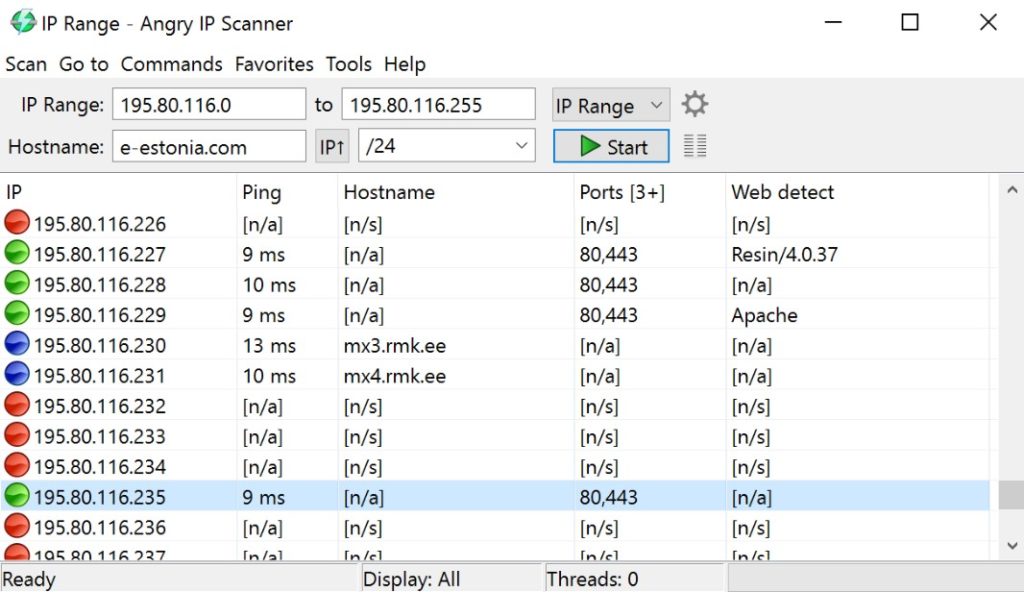
This open-source and cross-platform network scanner allows you to tailor your scans—you can scan entire networks, specific subnets, or specified ranges. As with Advanced IP Scanner, you can also input a text file with the IP addresses you want to scan. Using ping to find IP addresses, Angry IP scanner includes functionality to resolve hostnames and MAC address vendors—and for hosts offering support for it, the tool can integrate with NetBIOS information, as well. Angry IP Scanner also includes port scanner capabilities and will provide lists of the open ports for every host responding to the ping scan.
Though primarily a GUI-based tool, Angry IP Scanner offers a command-line version of the application, which is helpful for admins who want to bring all the program’s capabilities into their scripts. Scan results can also be exported as CSV and XML files.
4. SoftPerfect Network Scanner
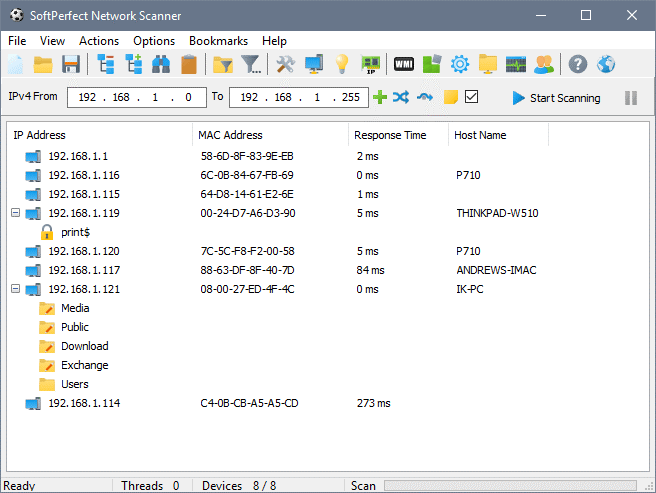
This IP address tracker and network scanner will scan IP address ranges and list the ones that respond. The scans will also bring back other information about the networked devices, like hostname, MAC address, and response time. SoftPerfect Network Scanner includes port scanning capabilities and can be configured to list the open IP ports on each host responding to the initial scan.
Like Advanced IP Scanner, SoftPerfect Network Scanner offers additional tools for Windows hosts, such as the capability to show the total shares on each host—including all the hidden ones—and can provide lists of the user accounts connected to each Windows device. Other added functions include the ability to send messages to all discovered devices on the network, remotely access computers, and run commands.
5. LizardSystems Network Scanner
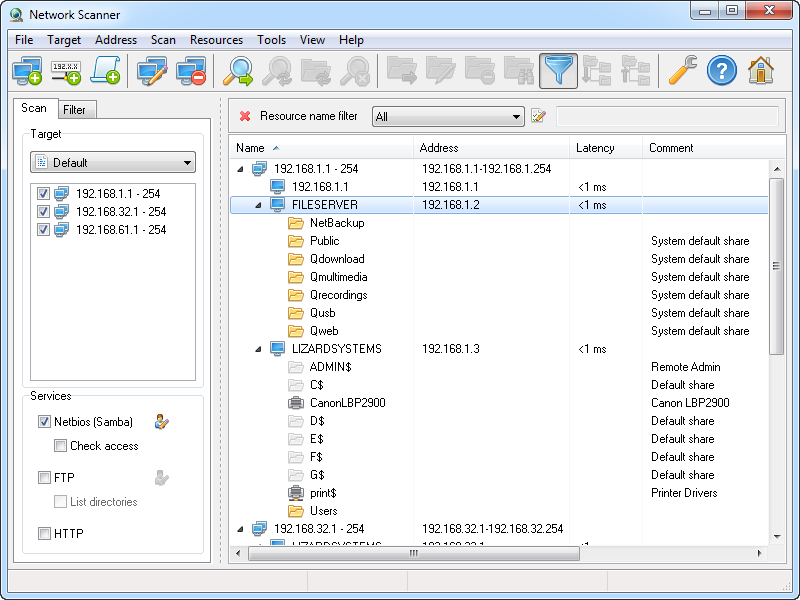
The IP tracker is web-based and its one major drawback is it can only be run on Windows with the use of Internet Explorer. This aside, it’s a comprehensive and easy-to-use tool providing many useful functions and capabilities. Not only does LizardSystems Network Scanner make use of multithreading—meaning it boasts excellent performance—but it’s intended to be scalable to grow with organizations as their network requirements grow and shift. Unlike some of the other free tools on this list, LizardSystems Network Scanner has no ceiling on the number of IP addresses it can scan and manage.
Other advanced features include the ability to filter the results of a network scan or to customize your status checks, so the application will run checks on specific ports you can set. LizardSystems Network Scanner can verify access rights for remote resources, retrieve NetBIOS information, and export scan results as HMTL, text, or XML files.
6. B-Labs Bopup Scanner
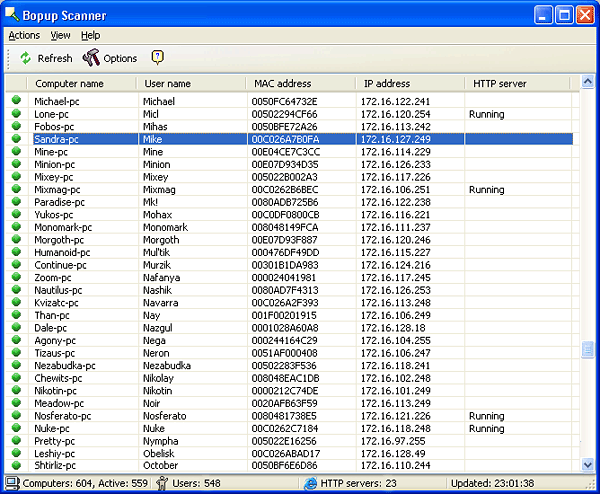
While B-Labs, the publisher of Bopup Scanner, usually creates messaging systems, they have branched out with this freeware network administration tool for Windows hosts. One unique thing about Bopup Scanner is it’s fully portable—meaning it doesn’t require setup or installation and can even be run from a flash drive or easily moved between workstations.
When performing a network scan, Bopup Scanner will return the IP address, hostname, and MAC address of each connected device, and can also provide information as to whether each host’s web server is responding. The program also lets you examine each host for available shares, specify the range of IP address to scan, and set response timeouts. This latter feature is a nice touch, if you ask me, because it keeps unresponsive IP addresses from bogging down the rest of the scan’s performance.
7. MyLanViewer Network/IP Scanner
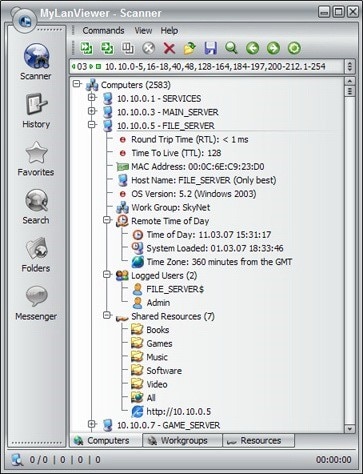
This free IP tracking solution is available for Windows systems and hosts, and the primary difference it offers has to do with how it displays the results of each network scan. The majority of IP trackers will generate a table listing the IP addresses and the other network parameters the scans detect, but MyLanViewer Network/IP Scanner instead displays the scan results in a tiered hierarchy resembling a file explorer window. Each host detected appears like a node in a tree-like structure, and each one can be expanded for further information.
Which IP Address Tracking Tool Should I Choose?
If you’re looking for an IP tracking software solution, there are a few options out there. Depending on the size of your network, you have plenty of free and open-source options available, but if you’re looking for a business-grade solution, I suggest looking at SolarWinds IP Address Manager. Free tools only go so far—for best-in-class features, a paid tool is worth it.
